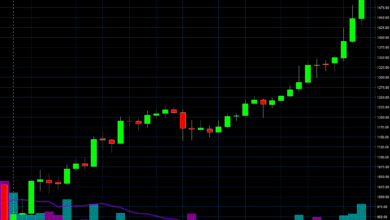Steve Cohen Market Commentary on Possible Stock Retests

In his latest market commentary, Steve Cohen highlighted the potential for a retest of the stock market’s lows from April, despite a robust recovery seen in recent weeks. The founder of Point72 voiced his views at the Sohn Investment Conference, suggesting that while he doesn’t anticipate a severe downturn, investors should prepare for a possible decline of 10% to 15%. His insights come on the heels of a significant jump in the S&P 500 performance, which rose by 4% after the U.S. and China initiated a 90-day negotiation period regarding tariffs. Despite this positive momentum, Cohen cautioned about the lingering economic recession risk that could become a reality if current market dynamics shift. He underscored the importance of keeping a close eye on investor outlook amidst these fluctuating conditions, reiterating that the market, while recovering, still harbors uncertainties due to ongoing tariff negotiations.
Recently, renowned investor Steve Cohen provided his expert analysis on the current state of the equity markets, indicating that a revisit to last April’s market lows could be on the horizon. At the Sohn Investment Conference, he underscored the importance of assessing the investor sentiment and highlighted the remarkable progress the S&P 500 has made in overcoming previous setbacks. With trade discussions between the U.S. and China paving the way for a potential pause in tariff impositions, a sense of cautious optimism has permeated the trading landscape. However, Cohen raised flags concerning the broader economic landscape, suggesting that while a recession is not imminent, the likelihood should not be dismissed as mere speculation. The complexities inherent in tariff negotiations and their implications for sector performance could continue to shape the investor climate moving forward.
Steve Cohen’s Insights on Market Recovery
Steve Cohen, the founder of Point72, recently shared his insights at the Sohn Investment Conference regarding the stock market’s trajectory. He noted that while there has been a significant recovery in stock prices, particularly in the S&P 500, there is a possibility for a retest of previous lows. Cohen assesses that although the market saw a 4% increase this week, signaling a positive trend for the year, the potential for a pullback of 10% to 15% exists. This perspective emphasizes a cautious investor outlook, especially at a time when many are closely watching economic indicators that could signal a downturn.
Cohen’s commentary highlights a critical juncture for market participants, particularly in light of the recent tariff negotiations between the U.S. and China. The temporary cessation of tariffs has provided a buffer for stock prices, allowing the S&P 500 to rebound fully from earlier sell-offs. However, Cohen warns that despite the market’s positive performance, it might feel ‘toppy,’ indicating that investors should remain vigilant. His insights underscore the intricate connection between governmental policies, such as tariff adjustments, and the broader stock market recovery.
Understanding the S&P 500 Performance Amid Economic Uncertainty
The S&P 500’s recent performance serves as a bellwether for broader economic conditions, reflecting both investor sentiment and the potential risks associated with an economic recession. Since the announcement of a 90-day negotiation period on tariffs, the index has gained traction, fully recovering from the lows experienced during the earlier tariff-induced sell-off. Investors are currently witnessing a dynamic environment where economic indicators, such as GDP growth and employment rates, are under scrutiny. The interplay of these factors is critical in determining the sustainability of the stock market recovery.
However, Cohen’s insights cast a shadow on the bullish sentiment permeating the market. Acknowledging the prevailing fears of a recession, he estimates a near 45% chance that the U.S. economy could slip into contraction, despite evidence of growth. His concerns about slow growth reflect broader insecurities, particularly with ongoing tariff negotiations, which could still impact market stability. Investors must cautiously assess market conditions, informed by both current performance metrics and the potential for shifting economic landscapes.
Investor Outlook: Recession Risks and Market Behavior
The current investor outlook is characterized by a mixture of optimism and caution, particularly in the wake of market recovery following a rocky period marked by tariff disputes. While many see the recent 4% rise in the S&P 500 as a signal of renewed growth, experts like Steve Cohen advise keeping a watchful eye on potential recession indicators. The chance of an economic downturn is a pertinent concern, especially with tariffs still looming over certain sectors and the general unpredictability of trade negotiations.
As Cohen notes, the economic environment is influenced by various factors—from tariff rates to sector-specific challenges. The perceived likelihood of a recession has given rise to strategic shifts in investment approaches, with many investors seeking to balance risk and opportunity amidst fluctuating market sentiments. Understanding these dynamics is crucial for maintaining an informed portfolio strategy that can weather the potential volatility predicted in the near term.
Tariff Negotiations: Impact on Stock Market Dynamics
Recent developments in U.S.-China tariff negotiations have played a significant role in reshaping market dynamics. The announcement of a temporary pause in tariffs has led to a noticeable surge in stock prices, which many attributed to increased investor confidence. This move has created a more favorable environment for the S&P 500, allowing it to fully recover from earlier losses. Investors are now hopeful that these negotiations will lead to a sustainable resolution that supports long-term economic growth.
However, there remains a palpable tension in the air, with many market observers wary of the impact ongoing tariff disputes could have on economic stability. The possibility of tariffs reinstated or new trade barriers could swiftly alter the current trajectory of market recovery. Steve Cohen’s commentary on feeling that the market is ‘toppy’ adds an additional layer of complexity, suggesting that investor sentiment could quickly shift depending on the outcomes of these negotiations and the economic indicators that follow.
The Role of Economic Indicators in Stock Market Forecasting
Economic indicators play a crucial role in shaping stock market forecasts and investor behavior. Recent trends suggest that even amid recovering stock prices, caution is warranted. As highlighted by Steve Cohen, the U.S. economy is on the brink, with a significant chance of recession. Key indicators such as employment rates, consumer spending, and tariff impacts must be closely monitored, as these variables can directly affect market performance and investor sentiment.
In light of Cohen’s analysis, investors are encouraged to remain proactive and informed about economic developments. An understanding of economic indicators, coupled with the current market recovery in the S&P 500, will help investors make educated decisions for their portfolios. This approach will allow them to navigate potential volatility as global economic conditions continue to evolve, ensuring that their investments are aligned with prevailing market realities and risks.
Strategic Investing Amidst Market Volatility
Navigating the stock market with a strategy during times of volatility requires a comprehensive understanding of economic conditions and investor psychology. As the S&P 500 has shown signs of recovery, with significant gains following the tariff pauses, the importance of a strategic investment approach cannot be overstated. Investors are advised to evaluate their risk tolerance and consider diversifying their portfolios to mitigate potential losses, especially in light of economic uncertainty highlighted by figures like Steve Cohen.
It’s essential for investors to recognize that despite short-term gains, the long-term fundamental outlook may present challenges. Tariff negotiations, potential economic slowdowns, and other market forces will continue to shape the investment landscape. Therefore, a prudent approach focusing on both short-term opportunities and long-term stability is vital for sustained growth and minimizing exposure during periods of economic turbulence.
Market Recovery Trends Post-Tariff Announcements
The recent shift in the market following tariff announcements marks a significant phase for investors aiming to capitalize on recovery trends. The S&P 500’s resurgence after a substantial dip demonstrates that investor confidence can rebound quickly with favorable policy changes. The circumstances surrounding the tariff negotiations, as detailed by Steve Cohen, illuminate how political and economic decisions intertwine and influence market trajectories, reinforcing that recovery can be both volatile and opportunistic.
Despite the optimism surrounding recent gains, understanding the nuances of ongoing tariff discussions remains crucial. Investors must keep a close watch on potential changes that could impact the stock market dynamics negatively, as any escalation in trade tensions could erode recent gains. The blend of market recovery and inherent risks calls for a diligent examination of investments, ensuring that strategies are robust enough to navigate potential pitfalls and sustained growth.
Assessing Stock Market Sentiment: Risk vs. Opportunity
The prevailing stock market sentiment hinges on a delicate balance between risk and opportunity, particularly in light of recent developments surrounding tariff negotiations. As noted by Cohen, the allure of potential gains can be tempered by underlying recession risks. Investors are tasked with assessing market conditions carefully and determining the right moment to act, weighing short-term recovery indicators against the backdrop of long-term economic uncertainty.
It’s essential for investors to cultivate a robust understanding of market sentiment, especially when navigating a recovery phase influenced by tariffs and geopolitical events. Engaging with tools that measure investor outlook can provide insights into prevailing attitudes within the market. This not only aids in informed decision-making but also prepares investors for potential shifts in momentum as economic factors evolve and impact the stock market landscape.
Long-Term Economic Projections: Cohen’s Cautionary Note
Steve Cohen’s assessment of the current economic landscape provides valuable insights for long-term planning. Despite the apparent stock market recovery, his caution about the risk of recession highlights the importance of strategic foresight in investment decisions. Investors must remain aware that macroeconomic trends, influenced by tariffs and international dynamics, can extend their impact over several months or even quarters.
By understanding the potential signals of an economic downturn, investors can create more resilient strategies that incorporate flexibility and risk management. Cohen’s take on a possible return to market lows underscores the necessity of maintaining a balanced portfolio that can withstand fluctuating conditions. Proactive investment strategies, rooted in an understanding of economic fundamentals, will be crucial for thriving in an unpredictable market.
Frequently Asked Questions
What does Steve Cohen say about the stock market recovery?
Steve Cohen highlights that the stock market has recovered significantly, particularly after a 4% increase in the S&P 500 this week. However, he also notes the potential for stocks to retest their April lows, which could be 10% to 15% lower from current levels.
How does Steve Cohen view the risk of an economic recession?
Steve Cohen estimates a 45% chance of the U.S. slipping into an economic recession. While he states that the economy isn’t in a recession yet, he points out the substantial risk factors including the impact of tariffs and slow growth.
What impact have tariff negotiations had on the stock market according to Steve Cohen?
According to Steve Cohen, the U.S. and China suspending reciprocal tariffs for a 90-day negotiation period has positively influenced the stock market, contributing to its recovery and the rise of the S&P 500.
What is Steve Cohen’s outlook on S&P 500 performance following recent market trends?
Cohen’s outlook for S&P 500 performance remains cautious; while he acknowledges the recent recovery, he suggests that a correction back to previous lows is still a possibility, indicating a market that feels ‘toppy’.
Why does Steve Cohen believe there may be a likelihood of stocks falling again?
Steve Cohen believes there’s a risk of stocks falling again due to several economic pressures, including tariffs and sector-specific economic concerns, despite the current stock market recovery.
Does Steve Cohen believe the stock market will face a substantial decline?
Steve Cohen does not expect a substantial decline in the stock market but mentions the possibility of a slight retracement towards previous lows, showing a cautious but optimistic investor outlook.
What does Steve Cohen think about the potential impact of tariffs on the stock market?
Steve Cohen indicates that tariffs have played a significant role in the economic environment and are affecting market performance. He suggests that the recent suspension of tariffs has led to a positive sentiment, yet underlying risks persist.
| Key Points |
|---|
| Steve Cohen’s view on the stock market’s future performance, suggesting potential retesting of April lows. |
| Cohen anticipates a minor decline of 10% to 15%, not a severe crash. |
| Recent market recovery linked to the temporary suspension of U.S.-China tariffs. |
| The S&P 500 has risen 4% this week, recovering from the April sell-off. |
| Cohen highlights a modest risk of a recession, estimating a 45% chance. |
| Market conditions described as ‘toppy’ by Cohen, indicating potential overvaluation. |
Summary
Steve Cohen market commentary reflects his perspective that while the stock market has rebounded significantly, there remains a possibility of retesting lower levels seen in April due to various economic factors. Cohen’s insights underscore a cautious yet optimistic outlook amidst the recent political developments affecting trade, suggesting that while substantial declines are not expected, vigilance is important given the looming risks of slow growth and potential recession.




